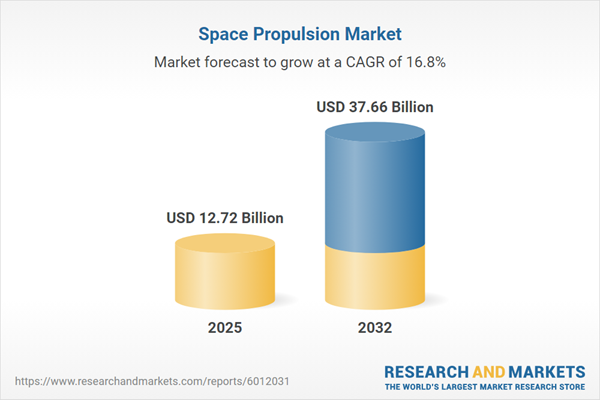Speak directly to the analyst to clarify any post sales queries you may have.
The space propulsion market is evolving rapidly, shaped by new technologies, shifting procurement realities, and diverse mission needs. Senior industry leaders require reliable insight to navigate this dynamic landscape and make confident, data-driven decisions regarding propulsion investments, partnerships, and procurement strategies.
Market Snapshot: Space Propulsion Market Size and Growth
The space propulsion market is projected to grow from USD 10.90 billion in 2024 to USD 12.72 billion in 2025 and is expected to reach USD 37.66 billion by 2032, reflecting a robust CAGR of 16.75%. This acceleration is driven by the expansion of satellite constellations, advancements in electric propulsion systems, and heightened ambitions for both commercial and government space programs. As capabilities and applications diversify, the propulsion sector remains a crucial enabler of mission success across every major region.
Scope & Segmentation
This report delivers a comprehensive analysis of the propulsion ecosystem, offering detailed forecasts and trends spanning the value chain.
- Propulsion Types: Chemical, Electric, Hybrid
- Vehicle Classes: Crewed Missions, Deep Space Missions, Launch Vehicles, Satellite Platforms (including Communication, Earth Observation, Navigation, Scientific, and Small Satellites such as CubeSat, MicroSat, NanoSat, PicoSat)
- Applications: Deorbit, Orbit Raising, Station Keeping, Transfer Maneuvers
- End Users: Commercial, Government, Military, Research Institutions
- Regions: Americas (United States, Canada, Mexico, Brazil, Argentina, Chile, Colombia, Peru), Europe, Middle East & Africa (notably United Kingdom, Germany, France, Russia, Italy, Spain, Netherlands, Sweden, Poland, Switzerland, United Arab Emirates, Saudi Arabia, Qatar, Turkey, Israel, South Africa, Nigeria, Egypt, Kenya), Asia-Pacific (including China, India, Japan, Australia, South Korea, Indonesia, Thailand, Malaysia, Singapore, Taiwan)
- Companies Profiled: Aerojet Rocketdyne Holdings, Safran SA, Northrop Grumman, United Launch Alliance, Lockheed Martin, Mitsubishi Heavy Industries, ArianeGroup, AVIO, IHI Aerospace, Rocket Lab USA
Key Takeaways for Senior Decision-Makers
- Propulsion technologies are diversifying, with electric propulsion moving from niche adoption to mainstream solutions, especially for satellite station-keeping and in-orbit maneuvering.
- Chemical systems remain essential for high-thrust operations and traditional launch vehicles, but modular, hybrid approaches allow for adaptability in complex and long-duration missions.
- Procurement is increasingly influenced by the need for modular and scalable propulsion subsystems that align with modern satellite architectures across both large and small platforms.
- Mission planners and integrators must balance key trade-offs among system performance, cost, regulatory compliance, and supply chain resilience when selecting propulsion solutions.
- Diverse regional dynamics mean that suppliers must navigate varied policy regimes, from strong domestic supply chains in the Americas to pan-regional collaboration in Europe, Middle East & Africa, and rapid capacity expansion in the Asia-Pacific.
Tariff Impact on the Space Propulsion Market
Recent tariff actions—particularly within the United States—have increased costs for some foreign-sourced propulsion components and raw materials. This has prompted firms to pursue alternative vendor qualification, expand local or near-shore manufacturing, and intensify compliance efforts. The lasting impacts include heightened visibility into supplier networks, additional transactional friction for cross-border sourcing, and increased vertical integration among propulsion manufacturers.
Methodology & Data Sources: Space Propulsion Market
This report applies a multi-method approach comprising structured interviews with propulsion engineers, procurement officers, and regulatory experts, along with a secondary review of technical literature, supplier data, and government filings. Supply chain mapping and scenario-based analysis strengthen insights into technology trajectories and procurement risks. All findings are validated with expert panels to ensure actionable and transparent conclusions.
Why This Report Matters for the Space Propulsion Market
- Enables executive teams to anticipate how emerging technologies and shifting procurement norms will affect competitive positioning and long-term portfolio strategy.
- Supports procurement and engineering leaders in identifying supplier risks, tariff impacts, and best-fit propulsion architectures for distinct mission needs.
- Equips organizations with actionable recommendations for diversifying sourcing and strengthening supply chain resilience in a changing regulatory landscape.
Conclusion
The propulsion sector is transitioning toward a multi-modal ecosystem, where modularity and resilience are central to next-generation mission design. Aligning technical strategy with procurement and compliance best practices will position stakeholders to capitalize on expanding market opportunities and navigate emerging risks with confidence.
Additional Product Information:
- Purchase of this report includes 1 year online access with quarterly updates.
- This report can be updated on request. Please contact our Customer Experience team using the Ask a Question widget on our website.
Table of Contents
3. Executive Summary
4. Market Overview
7. Cumulative Impact of Artificial Intelligence 2025
List of Figures
Samples

LOADING...
Companies Mentioned
The key companies profiled in this Space Propulsion market report include:- Aerojet Rocketdyne Holdings, Inc.
- Safran SA
- Northrop Grumman Corporation
- United Launch Alliance, LLC
- Lockheed Martin Corporation
- Mitsubishi Heavy Industries, Ltd.
- ArianeGroup SAS
- AVIO S.p.A.
- IHI Aerospace Co., Ltd.
- Rocket Lab USA, Inc.
Table Information
| Report Attribute | Details |
|---|---|
| No. of Pages | 189 |
| Published | October 2025 |
| Forecast Period | 2025 - 2032 |
| Estimated Market Value ( USD | $ 12.72 Billion |
| Forecasted Market Value ( USD | $ 37.66 Billion |
| Compound Annual Growth Rate | 16.7% |
| Regions Covered | Global |
| No. of Companies Mentioned | 11 |









